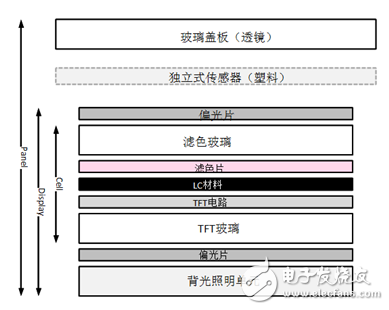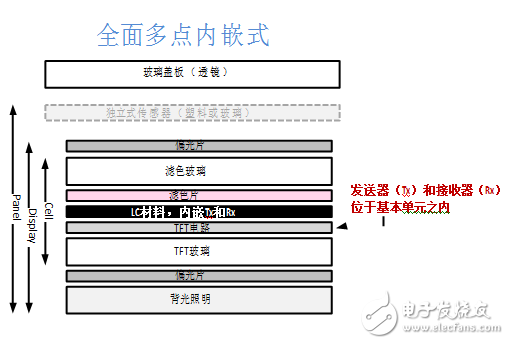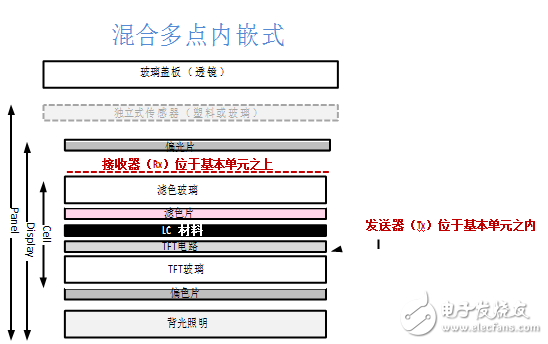Capacitive touchscreen technology has revolutionized the face of smartphones and tablets, and is now entering notebooks, desktop PCs, and the latest cars and wearables. Due to the fierce competition in these devices, manufacturers are constantly demanding systems designed to improve display quality and performance, providing a compact form factor, extending battery life and reducing costs, while requiring the system to be easy to use. Since the touch screen has a great influence on the user experience, whether a product can be successful or not, which touch screen design is selected may become a decisive factor.
To turn the display into a "touchpad", you need to seamlessly integrate the two previously separate features, touch and display. In the past, how to add touch sensors to display screens has been decided by different companies. The laminated panel stack consists of multiple layers. Different companies provide different layers. After that, it is possible for another manufacturer to assemble these layers. Become a display panel. Recent advances in technology have made it possible to integrate touch sensors directly into the display while integrating the touch controller and display driver into a single integrated circuit (IC).

Kevin Barber, Senior Vice President and General Manager, Smart Display Division, SynapTIcs
This article provides an overview of currently available touch and display integration technologies, including the latest, fully integrated solutions that are expected to lead new device designs for the foreseeable future. First, this article will introduce the various ways to integrate the touch sensor directly into the display, then explore the method of integrating the touch controller and display driver functions into a single IC, and finally focus on the integration of touch and display functions into device manufacturing. Many advantages brought by the business and its partners.
It should be noted that this article only targets smartphones and tablets with less than 8 inches (20 cm) of touch screen. Although it is possible to integrate touch and display functions in a larger touch screen in a similar manner, the two are quite different and it is necessary to introduce them separately.
Integrate touch sensors into the display overlay
Integrating touch detection and display update functions in the touch screen involves two aspects: display panel stacking; ICs that control both touch and display functions.

Figure 1 - The touch sensor can be added as a separate layer to the display of the composite panel, or it can be directly integrated into any existing layer in the display stack
Figure 1 shows that in a typical touch screen, there are many layers in the display overlay and display panel. It used to be common to cover the touch sensor as a separate or separate layer over the display in the laminated laminate display panel. With this design approach, the touch sensor is either added to the glass cover (CG) or placed in a dedicated sensor layer, which is typically made of plastic.
The method of integrating the sensor on the glass cover is sometimes called "Sensor-on-Lens" (SoL) or "One Glass SoluTIon" (OGS) because this The method does not need to add a separate sensor layer, only the glass cover can be used. The design method using the separate sensor layer is called Glass-Film (GF) or Glass-Film-Film (Glass-Film-Film) , referred to as GFF), depending on whether the touch send and receive functions are implemented on one or both layers of the sensor film. All of these design methods are called “separate†to emphasize the touch function as a cover on the display. The fact that the layer exists alone.
The advantage of adding a separate touch sensor overlay is that the technology is mature, the risk is low, and the product is on the market. Even when using the latest display and touch technology, a separate design is used, in which case the separate design is often integrated in subsequent design steps. Some LCD module manufacturers also attach great importance to the problem of using existing manufacturing systems and equipment in the factory. However, the disadvantage of the split design is that the display panel is thicker, the display is darker, and the cost is higher.
Due to recent technological advances, LCD module manufacturers are able to integrate touch sensors directly into one or more layers of the display overlay. This integration can be implemented on top of the base unit in the display or within the base unit, ie, on-cell integration or in-cell integration.

The method of placing the touch sensor matrix on top of the filter glass is called external integration because the sensor is located above the basic unit of the display. The sensor transmit and receive meshes (ie, diamond or stripe mesh) can be electrically isolated from the jumper or a special layout so that these meshes can be achieved without bridging. The latter design is called Single-Layer-On-Cell (SLOC), which is common because of lower cost and higher yield.
The use of external embedded technology to add touch functionality to the display is simple and reliable, and this method is often the best choice for active matrix organic light emitting diode (AMOLED) displays. For larger displays as well as curved or flexible displays, it is also a good choice to integrate metal mesh sensors without jumpers in an external way.
As shown in Figure 1, the basic unit in the display extends from the bottom of the thin film transistor (TFT) glass to the top of the filter glass, including the TFT circuit, liquid crystal material, and color filter. In in-line integration, the sensor builds a touch sensor matrix using the existing layers in the display. Typically, a touch sensor matrix is ​​placed on the common electrode (or VCOM layer), interconnected by a metal layer and a matrix. In the case of today's planar conversion (IPS) panels, these layers are all located on the TFT glass.
Another type of in-line integration is a hybrid design in which the transmission layer of the touch sensor is embedded in the TFT glass and the receiving layer is externally embedded in the filter glass. This method is called a hybrid multi-point in-cell (Hybrid In-Cell) design. To avoid confusion, the term "Full In-Cell" refers to both the transmitting and receiving touch sensor layers being located within the base unit. These two inline designs are shown in Figure 2.


Figure 2 – The location of the touch sensor's transmit and receive layers determines the type of embedded integration
5G Industrial Router features Application field
With the continuous progress and development of science and technology, a new generation of communication technology -5G is gradually entering our lives. In the industrial field, the application of 5G technology is also constantly advancing, bringing new opportunities and challenges to industrial production. Industrial routers, as one of the key devices for 5G applications, play a crucial role. This paper will introduce the definition, characteristics, application fields, development trends and other aspects of 5G industrial routers in detail.
What is 5G Industrial Router
Simply put, 5G industrial router is a special type of router equipment based on 5G technology, which is used to connect industrial equipment and systems to achieve high-speed transmission and exchange of data. Compared with traditional routers, 5G industrial routers have higher bandwidth and lower latency, which can better meet the requirements of real-time data transmission and high stability in industrial production environments.
Features of 5G industrial routers
First of all, high bandwidth is a significant feature of 5G industrial routers. The introduction of 5G technology enables industrial routers to support large-scale data transmission and processing, providing more powerful data communication capabilities for modern industrial production. Second, low latency is another important feature of 5G industrial routers. The advantage of low latency enables industrial routers to achieve real-time data transmission and processing, improving the efficiency and response speed of industrial production. In addition, 5G industrial routers also have the characteristics of high stability, high reliability and high security, and can cope with complex industrial environments and demanding data communication needs.
5G industrial router application field
First of all, the Internet of Things field is one of the important areas of 5G industrial router application. As the popularity and application range of Internet of Things devices continue to expand, the requirements for data communication are becoming higher and higher, and 5G industrial routers can provide reliable data connection and transmission services for Internet of Things devices. Secondly, the field of industrial automation is also one of the main application areas of 5G industrial routers. In industrial production, the transmission and processing of real-time data is crucial to improve production efficiency and quality, and 5G industrial routers can meet the needs of high-speed and low-latency data transmission to help achieve the goal of industrial automation. In addition, 5G industrial routers can also be widely used in intelligent transportation, smart cities, intelligent manufacturing and other fields.
With the continuous development of 5G technology, 5G industrial routers will also usher in a new development trend. First, with the popularity of iot devices, the demand for 5G industrial routers will further grow. Secondly, the introduction of virtualization and network slicing technology makes industrial routers have higher flexibility and scalability, in addition, the improvement of security will also become an important direction of the development of 5G industrial routers to cope with increasingly complex network threats and security challenges.
5G Industrial Router,Industrial Lte Router Poe,Industrial Security Router,Industrial 5G Cellular Router
Shenzhen MovingComm Technology Co., Ltd. , https://www.mcrouters.com
